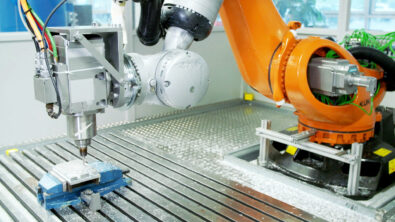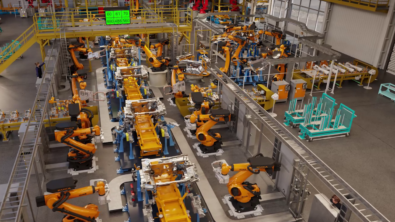Talking Aerospace Today – Automating the Mundane Part Two Transcript

In the latest episode of Talking Aerospace Today, Todd Tuthill and Patty Russo continue their exploration of automating the mundane, and how aerospace companies can implement it into their engineering processes.
Check out the full episode or continue reading for the transcript.
Patty Russo: Greetings and welcome to another episode of Talking Aerospace Today from Siemens Digital Industries Software. I’m Patty Russo, and I’m responsible for marketing for aerospace and defense vertical here at Siemens. Thank you for joining our conversation today. With me again is our aerospace and defense vice president, Todd Tuthill.
Patty Russo: In our last episode, we began an in-depth exploration of the five levels of digital transformation maturity. We learned much of the industry is already in the configuration and connection level of their digital transformation journey, so we started that conversation by exploring the next level, which is automation. Todd explained how automation could help make data work for engineers and speed up mundane tasks. He gave some examples of how automation has helped both outside the engineering world with his shopping—he’s not a shopper, we learned—he also explained how he and his team automated the process of writing test scripts and reports to deliver an aircraft control system on time. Today we’re going to build on those ideas and on that conversation.
Patty Russo: Welcome, Todd. Let’s start today’s discussion by revisiting the control system example. So automating test scripts and reports is obviously one great example of quote unquote automating the mundane, and it sounds like it not only saved time, but it freed up your engineers’ time to do other innovative, exciting work on top of saving time, I’m going to throw a little bit of a curveball and ask a question. Was there any output from that freed up engineering time that you can comment on that your engineers were able to do instead of doing those test scripts and reports at that in the in that example that you just gave?
Todd Tuthill: In that example, with the freed up time we were able to- we were able to meet our customer’s deadline. I’m confident we did not have-there were not enough hours in the day because the engineers were- we were working late hours still to get there because we had this massive, important deadline that we were trying to meet. And as we started that process, as we laid out the progress of what it was going to take to get to the deadline. It’s kind of like that scene in Apollo 13, you know, where they draw the moon and they draw the Earth and the, you know, the rocket gets halfway to earth before it runs out of oxygen. Well, that’s kind of what we were at.
Todd Tuthill: We were, the rocket was not going to get all the way to the Earth and we were not going to deliver this system on time for our customer and that’s, there was just no way to do it. You know, all the King’s horses and all the Kings men were not going to deliver this by control system on time. We had to have a new, innovative way and what this did, this allowed us to meet that deadline, and that that was the big key thing because, you know, as happens when you plan a test program, well, we’re going to run these tests a couple of times and modify them a couple of times and it never happens that way for anyone who’s done a significant test program to put an aerospace product in the in the world, you know that we had to run those test scripts and rewrite them ten, 15, 20 times. And if we had to do that manually, we’d have not made it.
Todd Tuthill: We’d have been on the cover of AVWeek. That’s what it would have been. Okay? “Program X doesn’t meet its milestone because the flight control system doesn’t work.” That’s the headline I had in my head, and when I was working to never see published, I’m proud to say it didn’t get published. And what actually did happen, we went from being one of the biggest risks on the program to a year later, we wanted the Supplier of the Year award from that particular OEM that we’re working for. And again, it wasn’t just because of this automation. It was because of a lot of hard work on the part of a whole lot of people in that company. But this automation was one very important key element in getting to that important milestone.
Patty Russo: So I would imagine that there are folks listening that are nodding their heads both on both ends of that of “Yeah, that’s a great place where we could benefit from it.” Or maybe some of our listeners are in the process of benefiting from automation. So these solutions to enable engineers to automate the mundane have been around for a while, I think. What we’ve seen, you and I have talked about this, that some customers have adopted and obviously you gave some examples. Some are a little slower to change and given the example that you just described or examples from other customers that you’ve talked about or talked to, where in an organization is a good place for a customer, a company to start with automation if they haven’t dipped their toe in the water yet?
Todd Tuthill: I think, look around, you know. Do an audit of where your engineers or your technicians spend their time. Start with a task that is repetitive. Writing test scripts, finding design information, writing test reports. Something like this, or with a task that’s repetitive, that’s not really that enjoyable and automate that. Because in the process, this is. a culture shift in many cases, and sometimes you’re fighting against people who are saying, “Well gee, we’ve never done it that way. You can’t work this way.” So you need some quick wins and I’d say start with something fairly small where you can see a quick win and prove the value of this new way of automating things and then build from there and you know, champion something, get some allies who understand how this can help your company, and then build from there. And look further and further. And don’t be afraid to shoot for the stars, but I don’t start there. Start with something simple. That’s what I would say.
Patty Russo: And to build on that, what, from your experience both talking to customers since you’ve been at Siemens and/or in your previous experience before Siemens, what are some considerations that companies should be aware of to avoid or to be aware of pitfalls, or maybe a false sense of what automation could potentially deliver? I think you know there’s like you said, shoot for the stars, but be realistic in your approach. What are some other considerations that should be on top of mind for our customers?
Todd Tuthill: There are several I can think of. So first off, think of the Betamax VCR discussion, and that’s going to go way back. I know probably most of our most of our listeners may have to Google that, that they won’t understand what a Betamax videotape is, or even what a videotape is. But suffice it to say Betamax was the better format, but VCR format won. Okay? Don’t be surprised when you come out with this new great idea. Automation is going to, you know, really help us. Not everybody’s going to be on your side. Okay? And you’re there’s going to be some detractors, and be patient with them and talk to them and try to see their side because this is not just a technology aspect. There’s certainly technology built into it, but it’s a culture thing too, and there’s a lot of culture built into this and a lot of, well, we’ve always written test procedures by hand in Microsoft Word, or test reports in Microsoft Word. It’s the only way we know how to do it.
Todd Tuthill: Yeah, I know hat’s the way we’ve done it, but think of all the time and really think about the people side and the culture side of this and don’t be surprised when there’s a lot of people who don’t think you can succeed, and maybe even don’t want you to succeed because it kind of changes the way they have to think about the way things work in their company or the way things have always worked. That would be one of the one of the things I would say.
Patty Russo: And that’s a great one. I think one of the quotes that comes to mind that I’ve used over the years is “change is hard.” And to your point you’ve given some great advice as to how to overcome, maybe that some of the challenges, organizational challenges around change. So once companies have automated, maybe have done one exercise or maybe two, automating the mundane like the test scripts and reports that that you were talking about, what’s next? What’s the next level of automation that they can look at to shoot for the stars, so to speak?
Todd Tuthill: Well then it really gets exciting, right? We’ve talked about automating mundane things and people can kind of wrap their head around that and that’s very important. But and this may even be a topic for our next podcast, because I think we’re probably running out of time, but I’ll refer people to again, maybe pre reading for the next podcast. Dr. Will Roper, the former Under Secretary for acquisition for the Air Force, wrote a great report called ”There is No Spoon,” where he described the whole new vision for the digital acquisition process, and he had a great term in there that I really like, that I like to use.
Todd Tuthill: He calls it authoritative automation and he talks about the ability to do things in the digital world that really change the way the physical world works, and to do more and more and more things digitally and virtually so that I can do fewer and fewer, I have to do fewer and fewer things physically. And that’s kind of the next step we want to take, and the next thing we can talk about is this whole concept of authoritative automation and where it really- People, we can kind of wrap our heads around to-I’m writing some scripts and I’m letting the scripts create test reports. We can think about that, but authoritative automation is really going far beyond that, and shooting for the stars. And that’s kind of the next place I see us going with authoritative automation, and on this journey of really making our data and our tools work for us, and really reducing the amount of overhead and the amount of work that we engineers have to do so that we can leave all the mundane stuff and even some of the other less important things to computers, so we can focus on critical decisions and innovation.
Patty Russo: That’s outstanding. And while I would love to drill down on that topic today, it’s probably best that we end our podcast on that note for today and pick that up in our next podcast. So unless there’s any other anything else you want to share about automation from what we’ve just talked about or maybe do a quick summary, it’s probably a good place to pause. Is there any other comments that you want to share before we sign off?
Todd Tuthill: I’ll just say that, you know, one of the things I hope you take away from this podcast is technology is the easy part. You know, the tools and things that we’ve talked about to help your company automate. They exist. They’re freely available. We had Siemens would love to help you along your journey to get there. But tools alone won’t get there. It’s about people, process and tools and it’s a cultural thing. And that’s why again, it’s good to partner with a company like Siemens. We have been through this process with many different companies and many different industries and we want to help you along that journey because we understand the tools are important, but it’s about a lot more than that. It’s people, process and tools. It’s a cultural change, too, that you’ll need in your company. That will be difficult at first, but in the end we’ll reap enormous benefits for you and for your customers.
Patty Russo: And a great note to go out on, so Todd, thank you so much for sharing your incredible experience and insights and expertise, and thank you to our audience for listening. We hope that you take some actionable ideas away and we look forward to the next time when we talk a little bit more about the later stages of digital transformation maturity and authoritative automation. So for now, we’re going to sign off and hope you have a have a great rest of your day, evening, morning, whatever day part it is.
Siemens Digital Industries Software helps organizations of all sizes digitally transform using software, hardware and services from the Siemens Xcelerator business platform. Siemens’ software and the comprehensive digital twin enable companies to optimize their design, engineering and manufacturing processes to turn today’s ideas into the sustainable products of the future. From chips to entire systems, from product to process, across all industries. Siemens Digital Industries Software – Accelerating transformation.


